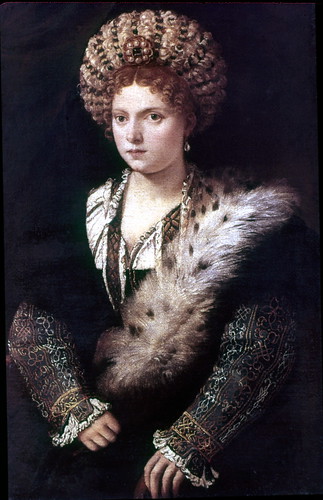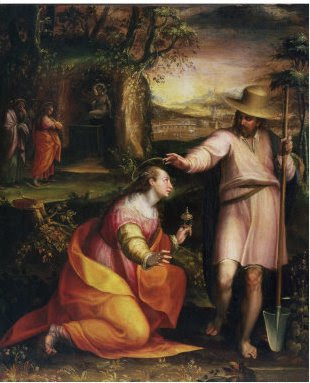Cards In This Set
| Front | Back |
|
Attributes
|
St. Peter: key
St. Jerome: Bible
St. Catherine: palm
st. Lucy: palm
|
 Image |
Bellini
San Zaccaria Madonna
1505
oil/wood to canvas
High Renaissance, Venice
-four saints (attributes)
-sacra conversazione (holy conversation): shows saints, angels,sometimes donors in the same pictoral space with enthroned Virgin & child
--individuals portrayed in mystical and eternal communion occurring outside of time
|
|
In situ
|
In original place or natural site
|
 Image |
Titian (&Giorgione)
Pastoral Concert (Fete Champetre)
c. 1510
oil canvas
|
 Image |
Titian
Pesaro Madonna
1519-26
oil/canvas
High Renaissance, Venice
-St. Peter: Key
-St. Francis: stigmata (marks resembling Christ's wounds) wearing red cloak
-atlar piece
-Madonna and Christ surrounded by members of Pesaro family (commissioners)
-grandeur of painting, with massive columns and marble staircase shows the power and glory of Pesaros.
-intersecting diagonals begin at Mary's head
|
 Image |
Titian
Venus of Urbino
c. 1538
oil/canvas
High Renaissance, Venice
reclining female nude- became popular with sophisticated court circles where they could look at nude Venus since it was mythological
-deliberatly provactive
-dog at end of bed symbolizes fidelity
-maids in background
|
 Image |
Titian
Isabella d'Este
1534-6
oil/canvas
High Renaissance, Venice
-Isabella was a great patron of the arts & dipolamat
|
 Image |
Veronese
Feast in the House of Levi
1573
oil/canvas
counter-reformation, inquistion
High REnaissance, VEnice
- intended to depict Last Supper, but it offended patrons because it was grandiose and pageant like (didn't represent a seder)
- impiety of surroundings of Jesus (man picking teeth, scruffy dogs, foreign soliders)
- as a result of this painting, Veronese was called before the Inquisition where Veronese retitled the painting to the Feast in the House of Levi
-Levi was a tax collector Jesus knew
|
|
Image |
Palladio
Villa Rotunda
Vicenza, begun 1550
High Renaissance
-not a villa (working farm), but a party house
-ionic order porch
-inspired by Roman Pantheon
-design has geometic clarity
--circle inscribed in a small square inside a larger square
--symmetrical rectangular rooms
-use of dome on domestic building secularized the dome and started the trend
|
 Image |
Pontormo
Deposition
1525-27
oil/wood
Mannerism, Florence
-emphasis on artifice at expense of naturalism
-elongated figures
-exaggerated poses
-altarpiece
-ambiguous composition enhaces visual qualities
-pink skin of man kneeling in front on a piece of cloth
-rocky ground& sky: don't know location of painting
- odd poses, drastic shifts in scale
-Pontormo's ideal was different: taller and thiner
|
 Image |
Sophonisba Anguissola
Sisters Playing Chess
1578
High Renaissance, Northern Italy
-shows wealth (clothing, tapestry)
-modest girls with a chaperone
-almost a genre scene (moves away from portrait)
-play chess (a man's intellectual game) shows that these women are intellectually accomplished & rational
-idealized landscape
|
 Image |
Lavinia Fontana
Noli Me Tangere
c. 1581
High Renaissance, Northern Italy
-continusous narration
-subject: bibical story of Christ revealing himself to Mary Magdalen following his Resurrection
-title is Latin for "do not touch me" because Jesus existed in a new form between physical and spiritual
-Mary Magdalen mistook Christ for a gardener, so Fontana painted him with a hat & spade
|
|
Iconoclasm
|
Destruction of images (after Reformation)
|
 Image |
Durer
Self-Portrait
1500
oil/wood
High Renaissance, Northern
-idealized, Christlike
-figure in severaly frontal pose, Durer's eyes meet the view like an icon
- robe & hair create a monumental equilateral triangle (symbol of trinity)
|
 Image |
Durer
4 Apostles
1526
oil/panel
High Renaissance, Northern
- apostles are reading the Bible to show their faithfulness
-Peter (1st pope) is on the left, receding into the background(diminishes importance of papacy)
-not idealized faces, Durer left wrinkles and blemishes
-may have been painted because Durer admired Luther and Durer wanted to show Protestant imagery was possible
-Lutheran Bible verses in German at the base of picture
-from left to right: JOHN, Peter, Mark, Paul
-Durer presented the painting to the Lutheran city of Nuremberg
|



